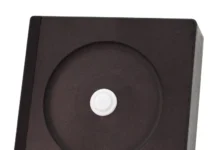Silanna UV, Brisbane, Australia, has announced new far UV-C and deep UV-C LEDs that take advantage of the company’s patented short period superlattice (SPSL) technology for industry-leading performance in the difficult-to-obtain 230 to 265 nm UV range – including the highest output power in any mass-produced UV LED at 235 nm.
The far UV-C 235 nm SF1 series and deep UV-C 255 nm SN3 series are available in either 120-degree or 30-degree viewing angle SMD packages, making them ideal for a wide range of tasks. The 30-degree package’s parabolic lens provides greater irradiance than even traditional UV lamps. Both the SF1 and SN3 series boast low power consumption and have exceptional operating lifetimes. These new LEDs offer the perfect solution for various deep UV and far UV use cases such as sterilization, water and gas sensing, and instrumentation applications. The 235 nm peak wavelength SF1 series comprises the 120-degree view angle (SF1-3C3FWL1), and the 30-degree (SF1-3U8P3L1). These far UV LEDs are effective for water quality detection of nitrate (NO3) and nitrite (NO2), gas detection and high-performance liquid chromatography (HPLC).
Silanna’s 255 nm deep UV-C SN3 series is ideal for water quality applications, including UV254 organic compound sensors, chemical oxygen demand monitoring and measurement of suspended solids. Other application of the SN3 series are ozone gas (O3) detectors and medical analyzers. Both 120-degree (SN3-5C3FWL1) and 30-degree (SN3-5U8P3L1) package versions are available. The 30-degree collimated source design of the SN3-5U8P3L1 package offers higher irradiance for enhanced resolution in sensing applications. Silanna UV’s groundbreaking patented SPSL approach overcomes many of the difficulties that plague competing AlGaN UV-C LED technologies.
By engineering a nanostructure from alternating layers of AlN and GaN, Silanna UV has developed a new material that is easier to control. Silanna’s SPSL mitigates several issues that AlGaN has for short wavelength LEDs – in particular, the older method’s poor light extraction and electrical performance.
For more information, visit http://www.silannauv.com/.






